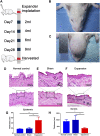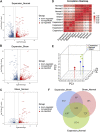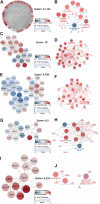Transcriptome Profiling Reveals Important Transcription Factors and Biological Processes in Skin Regeneration Mediated by Mechanical Stretch
- PMID: 34659370
- PMCID: PMC8511326
- DOI: 10.3389/fgene.2021.757350
Transcriptome Profiling Reveals Important Transcription Factors and Biological Processes in Skin Regeneration Mediated by Mechanical Stretch
Abstract
Background: Mechanical stretch is utilized to promote skin regeneration during tissue expansion for reconstructive surgery. Although mechanical stretch induces characteristic morphological changes in the skin, the biological processes and molecular mechanisms involved in mechanically induced skin regeneration are not well elucidated. Methods: A male rat scalp expansion model was established and the important biological processes related to mechanical stretch-induced skin regeneration were identified using Gene Ontology (GO) analysis, Kyoto Encyclopedia of Genes and Genomes (KEGG) analysis, and gene set enrichment analysis (GSEA). Analysis was also conducted by constructing a protein-protein interaction (PPI) network, identifying key modules and hub genes, determining transcription factor (TF)-mRNA regulatory relationships, and confirming the expression pattern of the TFs and hub genes. Results: We identified nine robust hub genes (CXCL1, NEB, ACTN3, MYOZ1, ACTA1, TNNT3, PYGM, AMPD1, and CKM) that may serve as key molecules in skin growth. These genes were determined to be involved in several important biological processes, including keratinocyte differentiation, cytoskeleton reorganization, chemokine signaling pathway, glycogen metabolism, and voltage-gated ion channel activity. The potentially significant pathways, including the glucagon signaling pathway, the Wnt signaling pathway, and cytokine-cytokine receptor interaction, were distinguished. In addition, we identified six TFs (LEF1, TCF7, HMGA1, TFAP2C, FOSL1, and ELF5) and constructed regulatory TF-mRNA interaction networks. Conclusion: This study generated a comprehensive overview of the gene networks underlying mechanically induced skin regeneration. The functions of these key genes and the pathways in which they participate may reveal new aspects of skin regeneration under mechanical strain. Furthermore, the identified TF regulators can be used as potential candidates for clinical therapeutics for skin pretreatment before reconstructive surgery.
Keywords: hub genes; mechanical stretch; skin regeneration; tissue expansion; transcription facotrs; transcriptome.
Copyright © 2021 Liu, Xiong, Zhang, Du, Dong, Yu and Ma.
Conflict of interest statement
The authors declare that the research was conducted in the absence of any commercial or financial relationships that could be construed as a potential conflict of interest.
Figures






Similar articles
-
Mechanical Stretch Induced Skin Regeneration: Molecular and Cellular Mechanism in Skin Soft Tissue Expansion.Int J Mol Sci. 2022 Aug 25;23(17):9622. doi: 10.3390/ijms23179622. Int J Mol Sci. 2022. PMID: 36077018 Free PMC article. Review.
-
Transcriptome analysis of regenerated dermis stimulated by mechanical stretch.Gene. 2025 Apr 5;943:149267. doi: 10.1016/j.gene.2025.149267. Epub 2025 Jan 20. Gene. 2025. PMID: 39842648
-
Deciphering Key Foreign Body Reaction-Related Transcription Factors and Genes Through Transcriptome Analysis.Front Mol Biosci. 2022 Mar 8;9:843391. doi: 10.3389/fmolb.2022.843391. eCollection 2022. Front Mol Biosci. 2022. PMID: 35350715 Free PMC article.
-
Construction and analysis of mRNA, miRNA, lncRNA, and TF regulatory networks reveal the key genes associated with prostate cancer.PLoS One. 2018 Aug 23;13(8):e0198055. doi: 10.1371/journal.pone.0198055. eCollection 2018. PLoS One. 2018. PMID: 30138363 Free PMC article.
-
Differentially expressed genes induced by β-caryophyllene in a rat model of cerebral ischemia-reperfusion injury.Life Sci. 2021 May 15;273:119293. doi: 10.1016/j.lfs.2021.119293. Epub 2021 Mar 8. Life Sci. 2021. PMID: 33705733
Cited by
-
Activating autophagy promotes skin regeneration induced by mechanical stretch during tissue expansion.Burns Trauma. 2024 Feb 7;12:tkad057. doi: 10.1093/burnst/tkad057. eCollection 2024. Burns Trauma. 2024. PMID: 38328438 Free PMC article.
-
Mechanical Stretch Induced Skin Regeneration: Molecular and Cellular Mechanism in Skin Soft Tissue Expansion.Int J Mol Sci. 2022 Aug 25;23(17):9622. doi: 10.3390/ijms23179622. Int J Mol Sci. 2022. PMID: 36077018 Free PMC article. Review.
-
FRET Visualization of Cyclic Stretch-Activated ERK via Calcium Channels Mechanosensation While Not Integrin β1 in Airway Smooth Muscle Cells.Front Cell Dev Biol. 2022 May 19;10:847852. doi: 10.3389/fcell.2022.847852. eCollection 2022. Front Cell Dev Biol. 2022. PMID: 35663392 Free PMC article.
-
S100 calcium-binding protein A9 promotes skin regeneration through toll-like receptor 4 during tissue expansion.Burns Trauma. 2023 Oct 31;11:tkad030. doi: 10.1093/burnst/tkad030. eCollection 2023. Burns Trauma. 2023. PMID: 37936894 Free PMC article.
-
The mechanotransducer Piezo1 coordinates metabolism and inflammation to promote skin growth.Nat Commun. 2025 Jul 25;16(1):6876. doi: 10.1038/s41467-025-62270-3. Nat Commun. 2025. PMID: 40715139 Free PMC article.
References
LinkOut - more resources
Full Text Sources
Miscellaneous

